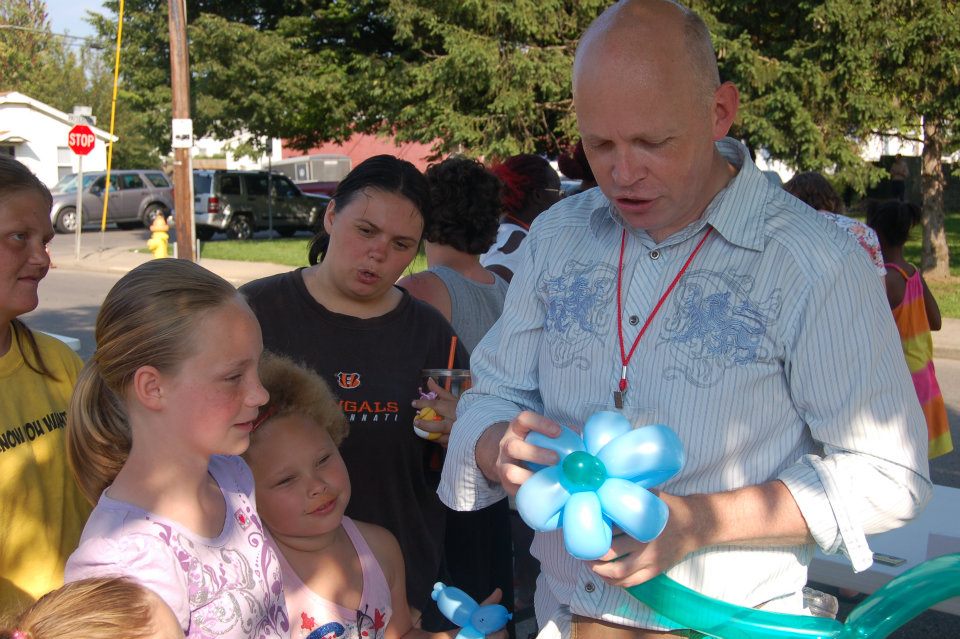Creating a Moment for Ministry Using Balloons
A few weeks ago, I shared a video about learning very basic ballooning for use in ministry. (That video is embedded at the end of this post.) I wanted to share a few tips about taking advantage of a moment like this with a kid in order to build them up. Although this is specifically about balloon sculpture, the principles apply in many interactions with kids.
Let’s consider the following example of a hypothetical interaction with a child getting a balloon:
Next!
What Would you like?
I can make a dog, cat, sword…?
OK, how about a dog?
(Twist, twist, twist.)
Here you go.
Next!
That experience was lot like the process of ordering something from a fast food restaurant. If things go well, you end up getting what you want. However, have you ever felt a special connection with your fast food order-taker? Have you ever felt better about yourself after a fast food transaction? Probably not. If we’re working with kids in a ministry setting, we can do better. Let’s re-imagine what the experience could have been:
Congratulations, you made it to the front of the line! What’s your name?
Emma, what’s your favorite color in the whole world?
Pink!? I should have guessed that from your pink shirt! (Gets out pink balloon.)
Do you have a favorite animal?
OK, so how about I make you a pink cat?
(Twist, twist, twist)
Promise to take good care of her? OK, then here you go!
This second version of this interaction didn’t take much more time, but the experience was significantly different. The focus wasn’t on the balloon, it was on the child. The child got to have a conversation with an adult who was interested in them. They got to feel special and cared about. And they got a balloon, too!
The most important part is to focus on the child, not the balloon. You’re not a “balloon distributor,” you’re a “creator of moments” and a “maker of memories.” So, don’t ask “What color do you want?” Ask “What’s your favorite color?” It’s not “What do you want?” It’s “Do you have a favorite animal?”
Here are a few other examples of ways to make a child feel special:
Sometimes a child will immediately ask for what they want. I’ll often reply, “I only make those for people I really like. Remind me again, do I like you?” Sometimes the child will get a big grin and reply, “Yes you do like me!” If they respond any other way (or just stare at me), I’ll immediately tell them “Of course I like you! I’m going to make a very special (thing you asked for) just for you!”
Sometimes a child will get to the front of the line and freeze up and get self-conscious. It’s especially bad if they’re with an adult who feels the need to tell you that they’re shy. (If someone’s feeling shy and self-conscious, about the worst thing you can do is point it out and try to force them to talk.) You’ll need to carry the conversation as if everything’s normal. Ask questions with an implied “yes” answer. If they don’t indicate otherwise, verbally or non-verbally, assume agreement and keep going. If they do start to speak, don’t make a big deal of it. Just keep going and ask another safe, simple question to keep them interacting. The goal is to help them feel safe and comfortable enough to interact with you. Given the short time available in this scenario, that may not be possible. But at least you can make it a positive experience for the child rather than an awkward or embarrassing one.
Look at their clothes for clues as to what they like. If a girl is wearing a pink outfit or a boy has a sports team jersey, that’s a big clue for picking a color they like. In any case, if they’re wearing a color, they probably don’t hate it. Based on what they’re wearing, I’ll pull out a balloon and say something like “How about we make you a (color) balloon?” “You look like a ‘dog’ person. How about I make you a (color) dog?” I’ll usually ask silly questions while making the balloon, like “How many legs should your dog have? Five? Six?” If nothing else, they’ll usually laugh or give me a look. In any case, I’ll act as if they responded and say something like “Yes, we should probably stick with a traditional four legged dog.” Even if the child never says a word, it can still be a fun, positive experience for them.
I think all adults have vivid memories from when they were a child of moments with adults. Unfortunately, many of those memories are probably bad ones–of times an offhand remark made you feel unwanted, unloved, or not valued. In retrospect, you probably realize most of these times the adult wasn’t intending to hurt you, and didn’t mean anything by their remark. However, that doesn’t change how you felt at the time. Hopefully, you also have childhood memories of moments with an adult made you feel special, valued, or loved. When I’m working with children, I try to always act as if my next interaction could be one of those they’ll remember the rest of their lives. I want to do my best to make sure it’s a good memory. Most moments are forgotten almost as soon as they’re over, but a moment can matter. Let’s strive to create meaningful moments with children.

